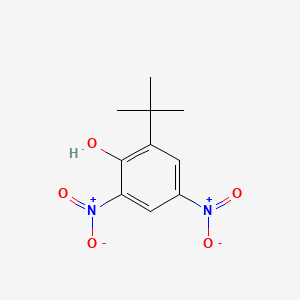D0891 | dinoterb
| Toxicity | Dose | Time | Species | Model | Method | Action | Positive criterion | Reference |
|---|---|---|---|---|---|---|---|---|
| MEMBRANE POTENTIAL | 0.48±0.00 | human | qHTS-HepG2 | MMP assay | decrease | IC50 | 163 | |
| MEMBRANE POTENTIAL | 2.24 | human | HepG2 | MMP assay | decrease | IC50 | 163 | |
| MEMBRANE POTENTIAL | 0.76±0.45 | rat | hepatocytes | MMP assay | decrease | IC50 | 163 | |
| Pictogram | Signal | Statements | Precautionary Statement Codes |
|---|---|---|---|
   |
Danger |
H300: Fatal if swallowed [Danger Acute toxicity, oral] H311: Toxic in contact with skin [Danger Acute toxicity, dermal] H360D ***: May damage the unborn child [Danger Reproductive toxicity] H400: Very toxic to aquatic life [Warning Hazardous to the aquatic environment, acute hazard] H410: Very toxic to aquatic life with long lasting effects [Warning Hazardous to the aquatic environment, long-term hazard] |
P201, P202, P264, P270, P273, P280, P281, P301+P310, P302+P352, P308+P313, P312, P321, P322, P330, P361, P363, P391, P405, and P501; (The corresponding statement to each P-code can be found at the GHS Classification page.) |
   |
Danger |
Aggregated GHS information provided by 38 companies from 1 notifications to the ECHA C&L Inventory. Each notification may be associated with multiple companies. H300 (100%): Fatal if swallowed [Danger Acute toxicity, oral] H311 (100%): Toxic in contact with skin [Danger Acute toxicity, dermal] H360 (100%): May damage fertility or the unborn child [Danger Reproductive toxicity] H400 (100%): Very toxic to aquatic life [Warning Hazardous to the aquatic environment, acute hazard] H410 (100%): Very toxic to aquatic life with long lasting effects [Warning Hazardous to the aquatic environment, long-term hazard] Information may vary between notifications depending on impurities, additives, and other factors. The percentage value in parenthesis indicates the notified classification ratio from companies that provide hazard codes. Only hazard codes with percentage values above 10% are shown. |
P201, P202, P264, P270, P273, P280, P281, P301+P310, P302+P352, P308+P313, P312, P321, P322, P330, P361, P363, P391, P405, and P501; (The corresponding statement to each P-code can be found at the GHS Classification page.) |
   |
Danger |
H300: Fatal if swallowed [Danger Acute toxicity, oral] H311: Toxic in contact with skin [Danger Acute toxicity, dermal] H360D: May damage the unborn child [Danger Reproductive toxicity] H410: Very toxic to aquatic life with long lasting effects [Warning Hazardous to the aquatic environment, long-term hazard] |
P201, P202, P264, P270, P273, P280, P281, P301+P310, P302+P352, P308+P313, P312, P321, P322, P330, P361, P363, P391, P405, and P501; (The corresponding statement to each P-code can be found at the GHS Classification page.) |
| Organism | Test type | Route | Dose (normalized dose) | Effect | Source |
|---|---|---|---|---|---|
| guinea pig | LD50 | skin | 150mg/kg (150mg/kg) | "Pesticide Index," Frear, E.H., ed., State College, PA, College Science Pub., 1969Vol. 5, Pg. 82, 1976. | |
| rabbit | LD50 | oral | 28300ug/kg (28.3mg/kg) | "Agrochemicals Handbook," with updates, Hartley, D., and H. Kidd, eds., Nottingham, Royal Soc of Chemistry, 1983-86Vol. A161, Pg. 1985, | |
| rat | LD50 | oral | 26mg/kg (26mg/kg) | Defense des Vegetaux. Vol. 26, Pg. 69, 1972. | |
| mouse | LD50 | oral | 19500ug/kg (19.5mg/kg) | "Agrochemicals Handbook," with updates, Hartley, D., and H. Kidd, eds., Nottingham, Royal Soc of Chemistry, 1983-86Vol. A161, Pg. 1985, | |
| 1420-07-1 | 2,4-Dinitro-6-tert-butylphenol | 2-(1,1-Dimethylethyl)-4,6-dinitrophenol |
| 2-tert-Butyl-4,6-dinitrophenol | 2-tert-Butyl-4,6-dinitrophenol [ISO] | 2-tert-butyl-4,6-dinitro-phenol |
| 2O5H456CFI | 4,6-Dinitro-2-tert-butylphenol | 4-06-00-03293 (Beilstein Handbook Reference) |
| AKOS015994017 | BRN 1887173 | C-14377 |
| C18671 | CAS-1420-07-1 | CC-11947 |
| CHEBI:81883 | CHEMBL1994620 | CTK4C2893 |
| Caswell No. 392F | DB-042599 | DINOTERB |
| DSSTox_CID_21883 | DSSTox_GSID_41883 | DSSTox_RID_79864 |
| DTXSID7041883 | Dinoterb 10 microg/mL in Acetonitrile | Dinoterb 100 microg/mL in Acetonitrile |
| Dinoterb [BSI:ISO] | Dinoterb, PESTANAL(R), analytical standard | Dinoterbe |
| Dinoterbe [ISO-French] | Dntbp | EINECS 215-813-8 |
| EPA Pesticide Chemical Code 228400 | FT-0633530 | HF-0007 |
| HSDB 1598 | Herbogil | IIPZYDQGBIWLBU-UHFFFAOYSA-N |
| KS-000026M0 | LS-104135 | MCULE-5591921524 |
| NCGC00160578-01 | NCGC00160578-02 | NCGC00254649-01 |
| NCI60_001301 | NSC 166496 | NSC-166496 |
| NSC166496 | Phenol, 2-(1,1-dimethylethyl)-4,6-dinitro- | Phenol, 2-(1,1-dimethylethyl)-4,6-dinitro- (9CI); |
| Phenol, 2-t-butyl-4,6-dinitro- | Phenol, 2-tert-butyl-4,6-dinitro- | Phenol, 2-tert-butyl-4,6-dinitro- (8CI) |
| Phenol, o-t-butyl-4,6-dinitro- | Phenol, o-tert-butyl-4,6-dinitro- | Phenol,1-dimethylethyl)-4,6-dinitro- |
| Phenol,2-(1,1-dimethylethyl)-4,6-dinitro- | Q1226713 | SCHEMBL53794 |
| Stirpan forte | Tox21_300743 | UNII-2O5H456CFI |
| ZINC1655733 |

